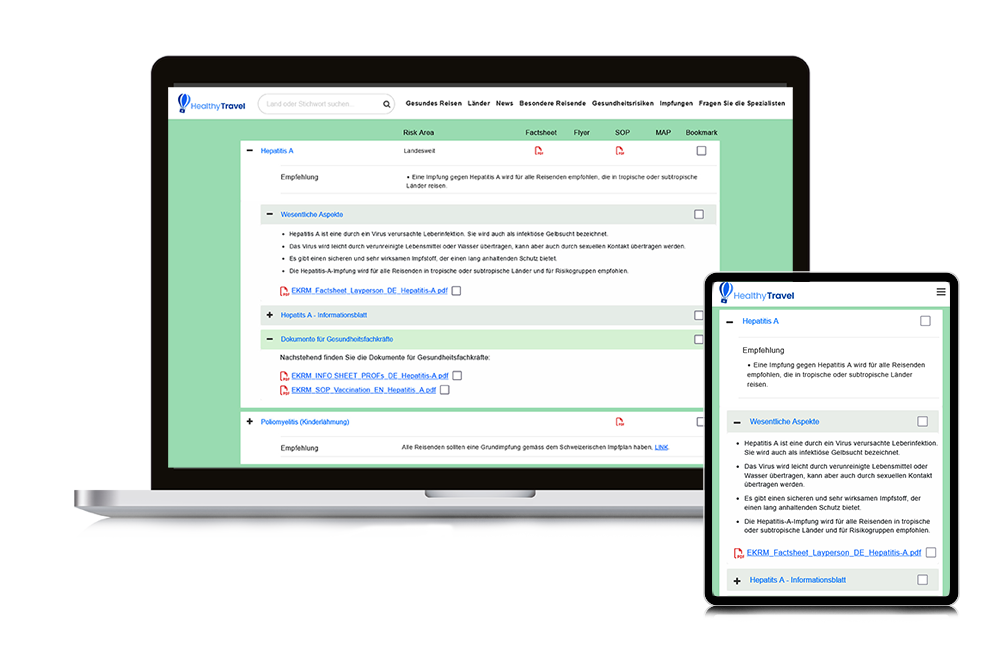Our Purpose
Healthy and safe travel - our main aim is that you can enjoy your trip in good health and that it becomes an unforgettable experience! We are at your assistance, whether with information for optimal travel preparation, vaccination recommendations, maps, tips in case of illness and much more! All information can be compiled and saved individually. The site is under construction and will be continuously expanded with additional content and updates.
Our Experts

Latest News
Get informed about the latest travel medicine news in your destination
Australien: Zahl der Melioidose-Fälle in Queensland stark gestiegen
Nach Angaben der Behörden wurden seit Jahresanfang und bis zum 6. April 2025 184 Fälle von Melioidose gemeldet – deutlich mehr als in den Vorjahren zur gleichen Zeit. Tatsächlich liegt die Zahl der Fälle in den ersten drei Monaten des Jahres 2025 bereits über den gesamten Jahreszahlen der vergangenen fünf Jahre.
Lokale Medien berichten ausserdem von 26 Todesfällen durch Melioidose in Queensland seit Jahresbeginn.
Melioidose, die durch das Bakterium Burkholderia pseudomallei verursacht wird, betrifft hauptsächlich Menschen, die direkten Kontakt mit kontaminiertem Boden und Wasser haben. Viele Melioidose-Patienten leiden an einer Grunderkrankung wie Diabetes (häufigster Risikofaktor), Nieren- und Lebererkrankungen und anderen. Informationen zur Melioidose: siehe CDC.
Algeria and Tunisia: Human rabies cases
Algeria: An 18-year-old man died on 4th Apr 2025 at the Ikhwa Toubal Hospital in Mila due to rabies, after being scratched by a cat he had taken into his home. According to sources, the incident occurred on 26 Mar 2025, but the patient did not receive vaccines as postexposition prophylaxis.
Tunisia: A 14-year-old boy died on 5 Apr 2025 after contracting rabies, according to the regional health director of Zaghouan. The child was infected by a dog bite a month earlier in the Hemamma area of El Fahs.
Philippines, Negros Occidental: Typhoid fever cases increasing 2025
Map source: www.philatlas.com
Typhoid fever cases in Negros Occidental have increased to 387 with 3 deaths from January to March 2025, the Provincial Health Office reported. This is 86% more than in the same period of 2024. The age group with the highest number of typhoid cases is 11 to 20 years. Typhoid fever is a life-threatening bacterial infection, commonly spread through contaminated food or water, or through person-to-person contact. This disease is most common in areas with poor sanitation.
Argentina: Significant increase of reported Zika cases
According to PAHO data, Argentina report an increase of Zika cases as of week 12 2025, compared to the same period of 2024: Since beginning of 2025 and as of week 12 497 cases (cumulative incidence 1.08) have been reported compared to zero cases in the same period of 2024.
Please note that these data represent the entire country, as PAHO does not provide subregional details.
Brazil, Espírito Santo: Oropouche fever – case serie on maternal and fetal implications
A recently published case series study examined the epidemiologic, clinical, and obstetric outcomes of pregnant women with Oropouche fever in Espírito Santo, Brazil, from March 28 to December 22, 2024. Among 4’062 reported cases, 73 involved pregnant women. Of 15 completed pregnancies, 14 resulted in live births and one in spontaneous abortion. Placental reverse transcription PCR tests were positive for Oropouche virus RNA in 5 infections in the third trimester. Two infections occurred in the first trimester, resulting in 1 spontaneous abortion and 1 live birth with corpus callosum dysgenesis. Among 13 third-trimester infections, one case showed possible intrapartum transmission with clinical symptoms in the neonate, while the others were asymptomatic. No anomalies were found in third-trimester infections.
The authors suggest that these findings indicate potential vertical transmission of the Oropouche virus and an association with spontaneous abortion or malformation. For details, see publication.
Entire Brazil: as of 19 March 2025, a total of 6’683 confirmed cases of Oropouche virus disease, with one death currently under investigation, have been reported in Brazil.
Saudi Arabia: Hajj and Umrah pilgrimage 2025
Hajj, the annual pilgrimage to Makkah (Mecca) in the Kingdom of Saudi Arabia (KSA) is one of the largest gatherings of its kind in the world. This year, Hajj will start on 4 June 2025. Usually approximately three million Muslims from around the world gather in Makkah for Hajj each year.
Umrah is a shorter, non-compulsory pilgrimage for Muslims, which is performed as part of the Hajj ritual, but can also be undertaken at any time. To perform pilgrimage, the Ministry of Health of the Kingdom of Saudi Arabia has issued new requirements and recommendations, see LINK and below.
Costa Rica: Malaria situation in 2024 - update
Im Jahr 2022 verzeichnete Costa Rica 411 lokal erworbene Malariafälle, die im Jahr 2023 um etwa 30 % auf 535 Fälle anstieg. Im Jahr 2024 war die Zahl auf 232 Fälle zurückgegangen. Malariafälle wurden in sieben Regionen gemeldet, wobei sich mehr als 80 % auf die Region Huetar Norte und Huetar Caribe konzentrierten.
Darüber hinaus kam es in der Region Brunca nahe der südlichen Landesgrenze zu einem Ausbruch, der mit den Migrationsrouten der Menschen durch Zentralamerika in Zusammenhang stand.
Botswana, Namibia: Significant increase in malaria cases in 2025
Botswana: On 25 March 2025, Botswana's Ministry of Health reported a significant increase in malaria cases reported in the past four weeks, related to recent heavy rains. This outbreak, which began in Okavango, has spread to several other districts. There have also been reports of cases in non-endemic areas, including Francistown, Gaborone, Mahalapye and Serowe.
Namibia: As of March 9, 2025, over 20,000 malaria cases have been reported. The most affected regions include the Caprivi Strip (particularly the cities of Katima Mulilo and Andara), areas along the Okavango River, and regions near the Angolan border, such as Outapi in the Omusati province, Eenhana and Okongo in the Ohangwena province, Nkurenkuru in the Kavango West province, and Nyangana in the Kavango East province.
USA, Canada: Significant increase of measles cases
Am 11. März 2025 erhielt die WHO von den USA einen Bericht über einen anhaltenden Masernausbruch, der aufgrund seiner erheblichen Auswirkungen als ungewöhnliches Ereignis für die öffentliche Gesundheit eingestuft wurde. Vom 1. Januar bis zum 20. März 2025 meldeten 17 Bundesstaaten 378 Masernfälle, darunter 2 Todesfälle – ein deutlicher Anstieg im Vergleich zu den Vorjahren und die ersten Todesfälle im Zusammenhang mit Masern in den USA seit einem Jahrzehnt. Die meisten Fälle betreffen ungeimpfte oder unzureichend geimpfte Kinder. Der Ursprung dieses Ausbruchs ist unbekannt.
Masern wurden in den USA im Jahr 2000 für ausgerottet erklärt, aber aufgrund ihres Vorkommens in anderen Ländern kommt es weiterhin zu eingeschleppten Fällen.
Before Travel
HealthyTravel Pro
HealthyTravel Pro for medical travel recommendations and consultations
- Content written by Swiss Expert Committee of Travel Medicine
- Recommended for professionals
- Updated on a weekly base
- Access to SOP
- Detailed maps

Updates of recommendations
Find out about the latest content updates on the websiteNew requirements and recommendations for pilgrimage 2025
New requirements and recommandations for Hajj and Umrah pilgrimage 2025 have been issued by Saudi Arabian Ministry of Health.
New Recommendations for Botswana, Namibia due to Malaria increase
Malaria recommendations have been updated for Botswana and Namibia.
Tanzania recommendations to prevent spread of mpox
Recommendations to prevent spread of mpox have been declared for Tanzania.
Yellow Fever Country List
The 'Yellow fever country list (vaccination recommendations and countries’ entry requirements) has been updated and is available on PRO Version -> yellow fever -> documents for professionals
Archive
Swiss Vaccination Plan - Update 2025
The Swiss vaccination plan 2025 has been published by the Swiss Federal Office of Public Health, issuing new recommendations for Switzerland.


